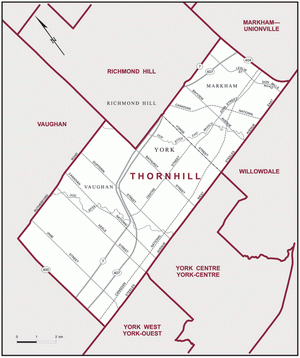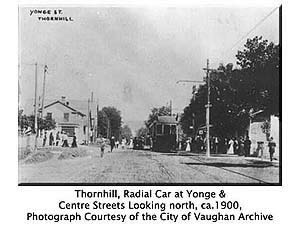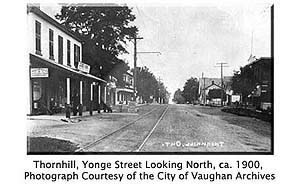|
History of Thornhill, Ontario
The growth and development of Thornhill is directly related to
several geographical factors, namely, the development of Yonge Street as
an important transportation route, the Don River system running through
the village, and lastly, Thornhill's proximity to Toronto.
 Thornhill
is divided in half between the Town of Markham and the City of Vaughan,
and runs along both the east and the west sides of Yonge Street. The first
Lieutenant-Governor of Upper Canada, John Graves Simcoe, first developed
Yonge Street as a military road. His initial attempt at trying to find a
north- bound route from Fort York (Toronto) along the Carrying Place Trail
was considered a failure. The Carrying Place Trail was an aboriginal route
to Georgian Bay along the Humber River system. Simcoe explored this route
in 1792, but found it very difficult and long to travel. On the way back
from this trip, a guide showed him a less known aboriginal route. The
trail connected Lake Ontario to Lake Simcoe from York (Toronto). A year
later Simcoe instructed Augustus Jones to survey the trail system that was
to be named Yonge Street. (Yonge Street was named after Simcoe's friend
and Minister of War, Sir George Yonge.) By 1793, William Berczy, had
cleared the trail as far as the present site of Thornhill. Later that same
year a group of soldiers, the Queen's Rangers, were dispatched by Simcoe
to finish the road to Holland Landing (Lake Simcoe). Yonge Street, the
longest road in Canada, was finally completed in January 1794. Thornhill
is divided in half between the Town of Markham and the City of Vaughan,
and runs along both the east and the west sides of Yonge Street. The first
Lieutenant-Governor of Upper Canada, John Graves Simcoe, first developed
Yonge Street as a military road. His initial attempt at trying to find a
north- bound route from Fort York (Toronto) along the Carrying Place Trail
was considered a failure. The Carrying Place Trail was an aboriginal route
to Georgian Bay along the Humber River system. Simcoe explored this route
in 1792, but found it very difficult and long to travel. On the way back
from this trip, a guide showed him a less known aboriginal route. The
trail connected Lake Ontario to Lake Simcoe from York (Toronto). A year
later Simcoe instructed Augustus Jones to survey the trail system that was
to be named Yonge Street. (Yonge Street was named after Simcoe's friend
and Minister of War, Sir George Yonge.) By 1793, William Berczy, had
cleared the trail as far as the present site of Thornhill. Later that same
year a group of soldiers, the Queen's Rangers, were dispatched by Simcoe
to finish the road to Holland Landing (Lake Simcoe). Yonge Street, the
longest road in Canada, was finally completed in January 1794.
In 1792, Simcoe announced a plan to attract settlers to Upper Canada
(Ontario). The plan offered 200 acres of land to pioneer settlers,
provided they undertake certain duties in return. Settlers had to clear
and fence 10 acres of grant land, erect a dwelling, and clear 33 feet of
land across the front of the property for a road. This work was to be
completed within two years of settlement. By 1800, all the lots between
what is now Steeles Avenue and Langstaff Road were granted to prospective
settlers. Simcoe's policies would populate and develop communities
throughout Upper Canada.
In the early 19th century, water was the main source of
power that drove industrial machinery. Thus the Don River played an
important role in the early development of Thornhill. It provided power
for saw and gristmills (flourmills) that were established in the area by
the new settlers. These mills helped produce lumber to build homes and
flour to help produce staple foods such as bread and other baked goods.
The earliest settlers were either United Empire Loyalists or Americans
taking advantage of the generous terms of Simcoe's settlement offer. In
1801, Jeremiah Atkinson built the first major saw mill on the Don, west of
Yonge Street in Thornhill. A gristmill was constructed in 1802 and
gradually, as a result of the mill, the first signs of urban settlement
began to emerge.
The years following the War of 1812 saw another wave of immigration
take place. The end of the Napoleonic Wars was characterized by
significant social and economic change in Great Britain. The result was a
period of emigration of upper class families, newly impoverished by the
upheaval, and of servicemen seeking to start a new life.
Of particular importance was the arrival of Benjamin Thorne in 1820.
Thorne set up a warehouse in York dealing in the export of grain and
import of iron. When William Purdy's Mill burnt down, Thorne purchased the
remains and erected a larger gristmill. By 1830, Thorne was operating a
gristmill, a sawmill, and a tannery. The small settlement came to be known
as Thorne's Mills and then Thorne's Hill after Benjamin Thorne.
In 1828, Thorne and his brother-in-law, William Parson, petitioned the
government for a post office. It was granted in 1829 and the village was
officially called Thornhill, with Mr. Parson being its first postmaster.
Thorne became the major influence in the economic life of the village.
A variety of industries, services and artisans had located in Thornhill
by the year 1830. Included among them were two sawmills, a distillery,
several blacksmiths and harness makers, two inns, a millwright, a
stonemason, a tanner, a weaver, a wheelwright, and a shopkeeper. (A first
account look at Thornhill during this period can be found in the diary
recordings of Mary Gapper O'Brien, published as "The Journals of Mary
O'Brien".)
Between the years 1830 and 1848, Thornhill experienced a period of
sustained growth and prosperity. The business district of Thornhill
developed on Yonge Street in an area between Centre Street and John
Street. Stagecoaches traveled between Holland Landing (Lake Simcoe) and
York (Toronto) as Yonge Street's road conditions improved with new grading
and stonework. During this prosperous period, many of the old churches,
which survive today, were constructed. Included among these were Trinity
Church (now Holy Trinity), built in 1830 and moved to Brooke Street in
1950; the British Methodist Church on Yonge Street, which was built in
1838 and moved to Centre Street in 1852 was partially destroyed by fire in
1983.
Agriculture prospered during this period as local farmers took
advantage of the new mechanical advances, such as reapers and threshers.
In addition, the millers found a ready market for their products in the
protected British market. The village came to acquire further services and
the original Crown lots were subdivided to provide for the needs of the
new urban class. By 1848, Thornhill was the largest community on Yonge
Street north of Toronto, having a population of approximately 700 people.
Thornhill had grown into a bustling, milling centre by the mid-1840s.
However, the factors that fostered its growth, namely government policy,
economics, and technology, all evolved and changed around mid-century
resulting in an extended period of stagnation. Foremost of these changes
was the British Government's repeal of the Corn Laws in 1846, which ended
lower import tariffs for Canadian grain into the British markets. Farmers
and millers were left with a glut of surplus grain. So serious was the
oversupply that Benjamin Thorne was left with large amounts of wheat with
no market. As a result, he went bankrupt. In 1848, the distressed Mr.
Thorne committed suicide soon after selling his asset and satisfying his
creditors. This was the first of a long series of events that eroded the
economic base of the village.
The decline in milling continued into the latter part of the 19th
century as less lumber was required for construction and was available for
milling. Agriculture was also in a state of flux by the mid-1870s. Farmers
to protect themselves against fluctuating grain prices, began to engage in
mixed farming, much to the disadvantage of the flour millers whose
services were required less and less. This economic downturn was further
exacerbated by the decline of soil fertility, which contributed to reduced
grain yields. Floods destroyed many of the remaining sawmills and fire
took its toll of the gristmills. By 1885, most mills had disappeared or
had been replaced by steam-powered operations.
 By
the mid-19th century, steam had replaced waterpower as the main
source of energy used in industry. Transportation was particularly
affected as the railroad tracks began to cross the countryside.
Communities sought to have the tracks run through their villages to take
advantage of the benefits the trains would bring. Thornhill, however, was
by-passed, thus losing a potential source of growth. In 1853, the Ontario
Simcoe and Huron Railway was constructed through Concord. By the end of
the 19th century, Thornhill had become primarily a service
centre for the surrounding farmland. By
the mid-19th century, steam had replaced waterpower as the main
source of energy used in industry. Transportation was particularly
affected as the railroad tracks began to cross the countryside.
Communities sought to have the tracks run through their villages to take
advantage of the benefits the trains would bring. Thornhill, however, was
by-passed, thus losing a potential source of growth. In 1853, the Ontario
Simcoe and Huron Railway was constructed through Concord. By the end of
the 19th century, Thornhill had become primarily a service
centre for the surrounding farmland.
In 1896, the new mode of transportation, the Metropolitan Radial
Railway (bus-like cabins on rails) reached
 Thornhill, bringing commuters to and from Toronto. Prior to that time, the
only public transit to the city was a three hour ride by stage coach. The
electric street railway was a significant improvement in both speed and
convenience and for the first time, it was possible to live in Thornhill
and work in Toronto. By the late 1920s, the automobile became a popular
source of transportation for many people, further facilitating travel on
Yonge Street.
Thornhill, bringing commuters to and from Toronto. Prior to that time, the
only public transit to the city was a three hour ride by stage coach. The
electric street railway was a significant improvement in both speed and
convenience and for the first time, it was possible to live in Thornhill
and work in Toronto. By the late 1920s, the automobile became a popular
source of transportation for many people, further facilitating travel on
Yonge Street.
Growth, however, remained slow until after World War I, when several
subdivisions were registered in the area and Thornhill acquired its three
golf courses: Uplands, Thornhill and Toronto Ladies. Much of the
subdivision activity in this period was speculative in nature and not
developed until after World War II.
 During
the early part of the 20th century, Thornhill was home to
several Group of Seven artists. J.E.H. MacDonald, Arthur Lismer, Fred
Varley, Franz Johnston and Frank Carmichael all lived in Thornhill in the
1920s enjoying and painting the rural beauty of Thornhill. During
the early part of the 20th century, Thornhill was home to
several Group of Seven artists. J.E.H. MacDonald, Arthur Lismer, Fred
Varley, Franz Johnston and Frank Carmichael all lived in Thornhill in the
1920s enjoying and painting the rural beauty of Thornhill.
In 1931, Thornhill became a Police Village. Until that time, Thornhill
had been a postal area with no independent municipal status. Thornhill had
been split between the then Townships of Markham and Vaughan along Yonge
Street since the initiation of municipal government in 1850. Each Township
administering their half of the village. The creation of the Police
Village gave Thornhill its own political boundaries. Three elected
trustees administered the village at this time.
The full effect of commuters and the northward growth of Toronto were
not felt in Thornhill until the years after World War II. Existing
subdivisions were completed and new ones registered as post-war prosperity
and the automobile brought families into the suburbs.
On January 1st, 1971, the Regional Municipality of York Act
came into effect, adopting the Metropolitan system of government. With the
creation of a regional government administration, the Police Village of
Thornhill ceased to exist and the administration of the community reverted
back to the newly created Towns of Markham and Vaughan.
Today, Thornhill is a large urban community with over 49 thousands
residents. Its ethnic composition is very diverse with a large Jewish,
Eastern European and Italian population. It is a community that has grown
expansively from its early beginnings, reaching north to Richmond Hill and
south to Toronto. Its residents enjoy all modern amenities for shopping,
recreational activities, schools, libraries and other conveniences.
|